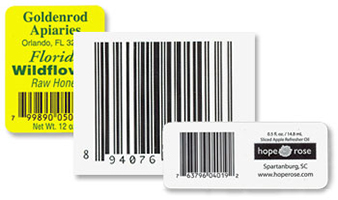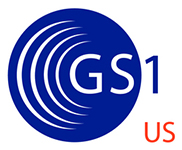
UPC barcodes are a helpful tool for manufacturers and retailers to keep track of product inventory and information. Furthermore, they’re often required to be on the product’s label or packaging to keep track of brands in the global supply chain. We’ve printed millions of barcodes and can help you understand what you need to know about UPC barcodes for internal and external usage. After reading this article, you should be better able to determine if you need a UPC barcode and how to go about obtaining one. You can also check out our barcode glossary for more information on retail/non-retail barcodes.
Get started on your barcode labels with our instant online quote!
What is a UPC barcode?
‘UPC’ stands for Universal Product Code, a unique 12-digit number assigned to retail merchandise that identifies both the product and the vendor that sells the product. Barcodes used in retail (like UPC, EAN, and JAN) are regulated by GS1, an international non-profit organization responsible for influencing and maintaining efficiency standards to meet global supply and demand. UPCs are the most commonly used barcodes in the U.S. They’re accompanied by an optical bit of data known as a barcode that displays a unique set of numbers and bars.

When a UPC barcode is scanned, it quickly communicates a product’s information whether it’s between a manufacturer and retailer, or within its internal departments: shipping, inventory, pricing, and point-of-sale (POS). With a scanning device, a barcode’s numbers are read by the varying widths and heights of the bars compared to the widths of blank spaces between them. The scanner identifies the sequence of numbers and recalls the product’s information on a computer, tablet, or smartphone using a barcode software.
The UPC was originally developed for the grocery industry but has since spread to almost all areas of retail business. UPC barcodes not only make it easy to identify products but they also allow retailers to program their POS systems with prices and other necessary information for each product.
Things To Know About Using UPC Barcodes
Now that you have a better understanding of what a UPC barcode is and how it works within retail merchandise, let’s discuss some of its capabilities and limitations.
- UPCs Do Not Carry Prices – The UPC code simply identifies the product. When the UPC is scanned at the store, the retailer’s computer POS system pulls up the most current price for that item. That price is created by the retailer and inputted into the POS system prior to the product being put on the shelf. This way, a retailer can set their own prices. The retailer can input any information they want with the UPC, such as store warranty, product color, shape, etc.
- One for Each Product – A UPC is designated for each individual product, manufacturer, and product type/quantity. For instance, a two-ounce cup of chocolate ice cream, a 60-ounce tub of chocolate ice cream and a 60-ounce tub of vanilla ice cream all have different UPC codes, even if they are all made by the same company.
- Internal Usage – You don’t need to join or pay fees to GS1 or GS1-US for your organization to use UPC barcodes within your internal communication systems. Here are certain GS1 prefixes specifically assigned for internal usage listed as “Restricted distribution (MO defined)”: https://www.gs1.org/barcodes/support/prefix_list. Another option for internal barcodes is to use another type of barcode symbology (aka class of barcode). UPCs have a fixed length code that must be exactly 12-digits long and contain only numbers. There are other types of barcode symbols (like Code 39 or Code 128) that can handle both letters and numbers and can be as long or short as you need.
- Not for Internet Sales – A UPC barcode is primarily used by store retailers and isn’t mandatory to sell a product. If you sell your products via the Internet, you don’t need to join or pay GS1. You may use any barcode you’d like for internal purposes. If you sell to a separate Internet retailer, that retailer may require a barcode. We recommend that you ask the retailer of their needs well in advance.
- Country Prefixes – A UPC barcode doesn’t identify a product’s country of origin. The country prefixes are used to provide the identity of the company’s location. Those companies, however, may manufacture products around the world.

How to Get a UPC Barcode
To get an official UPC barcode, you must obtain a unique GS1 Company Prefix by joining GS1. By paying an initial fee and an annual maintenance fee, you will be able to use up to 100 UPC codes. GS1 has prepared a 10-step list to implementation, from gaining a Company Prefix, configuring size and color, to testing the quality of readability. Please visit https://www.gs1.org/barcodes/implementation for more information. For an estimate of your fees, please visit GS1’s Barcode and Fee estimator on their GS1-US website.
Remember, you don’t need a company prefix for internal usage, but it will be necessary to get one if you plan on selling your products in retail stores where official UPC barcodes are required.
Design considerations for barcodes:
There are a couple of things to consider when you’re designing your barcode to ensure they not only look good but also work properly with scanners.
- Size – When it comes to UPC barcodes, size matters. For instance, UPC-A (the most common form of a UPC barcode) can be only reduced or magnified anywhere from 80% to 200% of its original size of 1.46” x 1.020.” Smaller products generally have less label space and could benefit from shorter code variations such as UPC-E.
- Resolution – Having a big UPC doesn’t necessarily mean it will have a high resolution. Even billboard-size QR codes can be difficult to scan if it’s not printed in high resolution. Please contact our customer service team to make sure your artwork is of high enough resolution to be easily scanned.
What’s the difference between barcodes?
Different barcodes are scanned for different bits of information, in different ways, and used for various purposes. While UPCs are mostly used by U.S. retailers to identify one product from another via a horizontal scanner, other codes are used to identify product names, coupon discounts, zip codes, website URLs, and more. Some codes can even be scanned from an omnidirectional angle, meaning any possible angle. Internationally, many retailers use different barcodes – such as EAN – to function in their own POS systems. For more information, please see our barcode glossary.
Editor’s Note: This post was originally published in March 2012 and has been updated for accuracy and comprehensiveness.


